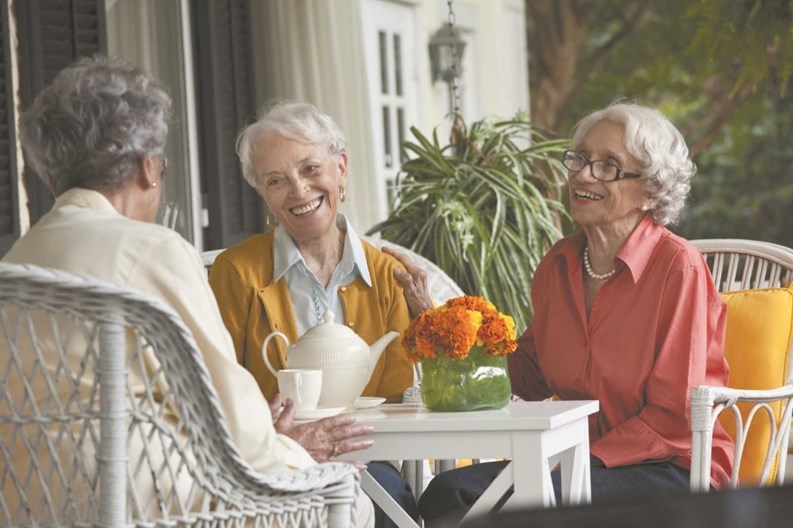Citizens over the age of 65 comprise nearly 13 percent of the U.S. population—just under 40 million seniors. By 2030, it is estimated that 72 million Americans will be over the age of 65, nearly doubling those numbers. Where this volume of seniors will live and how, is a question facing not only the individual seniors but also many boards and property managers, who are seeing an increased population of older residents. It is to be expected that this group will dramatically change the face of aging and retirement.
New Trends for Older Residents
Ellen Hirsch de Haan, of the law firm of Becker & Poliakoff in Clearwater, is an attorney, educator and author who has written a book on aging in place for the Community Associations Institute (CAI) and teaches courses to property managers. She has noted several new trends in the pre-boomer generation. “Pre-boomers were looking for destination retirement,” de Haan explains. “They were looking for a lifestyle. Boomers are looking for location: they want the pool, the activities, and the gym.”
Pre-boomer retirement centers were first successfully developed in Arizona and California by Del Webb in the early 1960s. Since then they have expanded to every state, with a variety of options available. Although for many, retirement center conjures up the image of a white-walled, isolating institution, with not much more than a Tuesday night Bingo to participate in, there is a new wave of brighter, more modern living situations available. With a longer-living, more physically and socially active retiree population, communities are changing to properly accommodate it.
Aging in Place
And while there are a number of such retirement communities in New England, including Del Webb’s Great Island community in Plymouth, Massachusetts, services for NORCs are extending beyond the bounds of planned developments to city and town neighborhoods. In Massachusetts, for example, the state FY2012 budget includes $1.6 million for Naturally Occurring Retirement Community (NORC) programs that “deliver services, develop partnerships, mobilize in-kind resources, and foster the creation of environments that promote aging in place.”
The Jewish Community Relations Council, which had promoted the budget line item, noted when the budget was passed in July, “These programs are a cost-effective way to keep seniors in their homes and out of nursing homes and allow them to age with dignity and in their communities. NORCs also have wide support because they reduce MassHealth expenditures by keeping seniors in their homes and out of more costly facilities.”
While relocating to a community of retirees is a popular option, recently many boomers are deciding to stay at home, a process accordingly named “aging in place” or be a part of a Naturally Occurring Retirement Community. While both these concepts involve experiencing retirement in one's home and neighborhood, there is slight difference between the two. “A NORC is one way of aging in place. A NORC is a group of individuals who live in their own homes and they have come together for the purpose of getting services that may normally come through an assisted living or retirement community. They have hired or have a volunteer that performs the functions. It becomes in essence, a loose retirement community within a geographic neighborhood where they is some sort of due structure to pay for the services,” says Penny Cuff, senior program officer for Partners for Livable Communities based in Washington D.C.
“A more general way of aging in place is simply described by individuals aging in their own home and own community. And they are not organized or structured, they are just there. Still, these individuals need some form of support, that is hard to come by if you are not organized. It is up to communities to look at this situation at most people in the country growing old in their own homes and saying 'what can we do to interact with these people'?” she says.
Kings Way, a Cape Cod condominium community, built around The Golf Club at Yarmouthport, was not designed as a “retirement” community, though many of its residents fall into that category. Described on its website as “a vibrant, active community offering golf, tennis, croquet, fitness, aquatics, cultural and social activities, fine arts, and fine dining,” Kings Way has the feel of a traditional New England town, with a village green, meeting house and post office—a setting that works well even as residents get older.
And in Connecticut, seniors form a dominant demographic in the town of Southbury, for example. According to a New York Times article, more than 30 percent of Southbury’s population is over 60, a segment expected to be about 40 percent by 2020. Nationally, according to the 2010 census, the population over age 62 grew by 21 percent in a decade, compared with just 2.6 percent for those under 18. Maine had the highest median age, 42.7, followed by Vermont, West Virginia, New Hampshire, Florida, Pennsylvania and Connecticut, whose median age was 40. In 2000, no state had a median age above 40.
In addition to Heritage Village, where the median age is 77, Southbury has the Grace Meadows public housing complex for the elderly, three assisted living centers, and two nursing homes—all in a town with less than 20,000 people—which provide an interdependent network of services. After spending time rehabilitating at the River Glen Health Care Center following hip replacement or heart surgery, a resident of Heritage Village might move back home or into an assisted living center like the Hearth at Southbury, Pomperaug Woods or the Watermark at East Hill; eventually, they might relocate to the Lutheran Home, which specializes in dementia care.
“When Heritage Village first came in, it was us versus them,” said First Selectman Bill Davis, speaking about the sprawling 55-and-over complex of 1,000 acres and about 4,000 residents, which opened in 1967. “But now, almost anything we do we take them into account. That’s who we are. We’re an elderly-based community,” he told the Times.
As healthcare and living standards are improving, many seniors are able to care for themselves longer and decide to stay in the community where they grew up in. As more and more retirees choose to do so, many communities naturally accumulate a large senior population, that has different demands and concerns than the younger population. Because of this trend, property managers and boards may need to make modifications in order to better address the needs of an aging and changing population.
Retrofitting Homes
In terms of actual residence design, Cuff believes that boards and managers should look into and implement ‘universal design,’ which focuses on certain aesthetic aspects such as the width of the doorway, height of the counter tops, and grab bars in the shower. “Universal design is something that everyone can use from time to time, everyone with a disability and certainly older individuals. But it doesn’t get used often enough,” she says. The concept of universal design was first fully studied and implemented by Selwyn Goldsmith in the 1960s. The principles focus on design that is accessible and barrier-free to people with and without disabilities. Goldsmith’s most significant achievement was the creation of the dropped curb—now a standard feature of the built environment.
Cuff also mentions that especially for older residents, it is the small touches that make a big difference. She recalls an instance with her mother-in-law, who lived well into her 90s and her last apartment had wall-to-wall carpeting. “It was something I hadn’t consciously thought about but it was perfect. It provided a soft surface in case you slipped and fell but also some traction,” she says.
In addition to universal design, there are more specific considerations that should be made. “When designing or retro fitting a community for older adults, the architect needs to ensure that floor surfaces are nonskid and not shiny,” explains Marjorie Jean Meyer, CMCA, PCAM, who is in charge of Leisure and Lifestyle programming at Associa, a professional management company. “All possible trip hazards should be eliminated, and lighting needs to be brighter.” She also suggests that boards and management companies are cautious, consistent and timely when making accommodations for any special needs.
When Wendy Murray, regional director of sales and marketing at Associa, assesses an existing property for senior friendly renovations she looks for areas that need handrails, or ramps, increased signage or lightning, or anything presenting a trip hazard and finally she follows the Federal Fair Housing Act in a consistent and timely manner.
In developing a disaster plan for any property, Murray takes age into account. She is a proponent of disaster drills to identify any weaknesses, and to assure any residents with special needs have viable options. With an older population, she checks for exits and other signs to be clearly visible, and lighting to be bright. The location of services should be wheelchair accessible and information on medications and next of kin readily available.
More than Bingo
Social interaction plays a huge role in successful aging in place, contributing to the well-being of the community as well as improving functionality and effectiveness in governance.
Steve Travis, a resident of Great Island in Plymouth—which was designed for seniors—and editor of a newsletter about the community, says, “First and foremost, Great Island is a community; a community in the full sense of the word. The reason for this is very simple; people come to Great Island for the community and they make community an important part of their life-style. The friendly nature of the community is contagious.”
It is a sentiment shared by Murray who sees many seniors aging successfully. She considers older adults a positive influence for a number of reasons. “Older adults tend to be retired and able to attend meetings held during the day, such as city council or county commission meetings,” states Murray. “They tend to volunteer on multiple committees and are willing to assist in researching issues and hot topics.”
Murray cites security as another plus, since older adults are often home during the day, they recognize normal activity, and are great on crime watch committees and reporting unusual activities. “Older adults are a tremendous resource to a community,” she explains.
Communication is Key
Because retirees are making up a large percentage of communities, boards and property managers should keep communication open and frequent in terms of finding out how they can better serve and accommodate this population. The first step to do so? Having a conversation. “Boards and managers should simply talk to older people, find out what it is that they would like to see, maybe have a focus group,” says Cuff. “They should also have someone on the Board that is older to be well represented.”
Communication can even uncover a community’s overlooked willingness to help out. Cuff cites a successful example in her neighborhood in which the older residents were considering forming a NORC but reconsidered after public awareness and a few meetings uncovered that volunteers were willing to help out. “We did an assessment of the people, to see what their needs were and then we assigned an individual as a responsible person to check in on them and support them. It is all very informal and friendly.” A retiree volunteer program can be easily implemented in many condo and co-op communities; all it takes is a little awareness, communication and compassion.
An increasing population of older residents benefits any community in numerous ways. Through open communication, boards and management companies can create a safe, stimulating and interactive community that not only houses but also engages older residents for many years to come.
Anne Childers is a freelance writer and a frequent contributor to New England Condominium and other publications. Associate Editor Pat Gale contributed to this article.







Comments
Leave a Comment